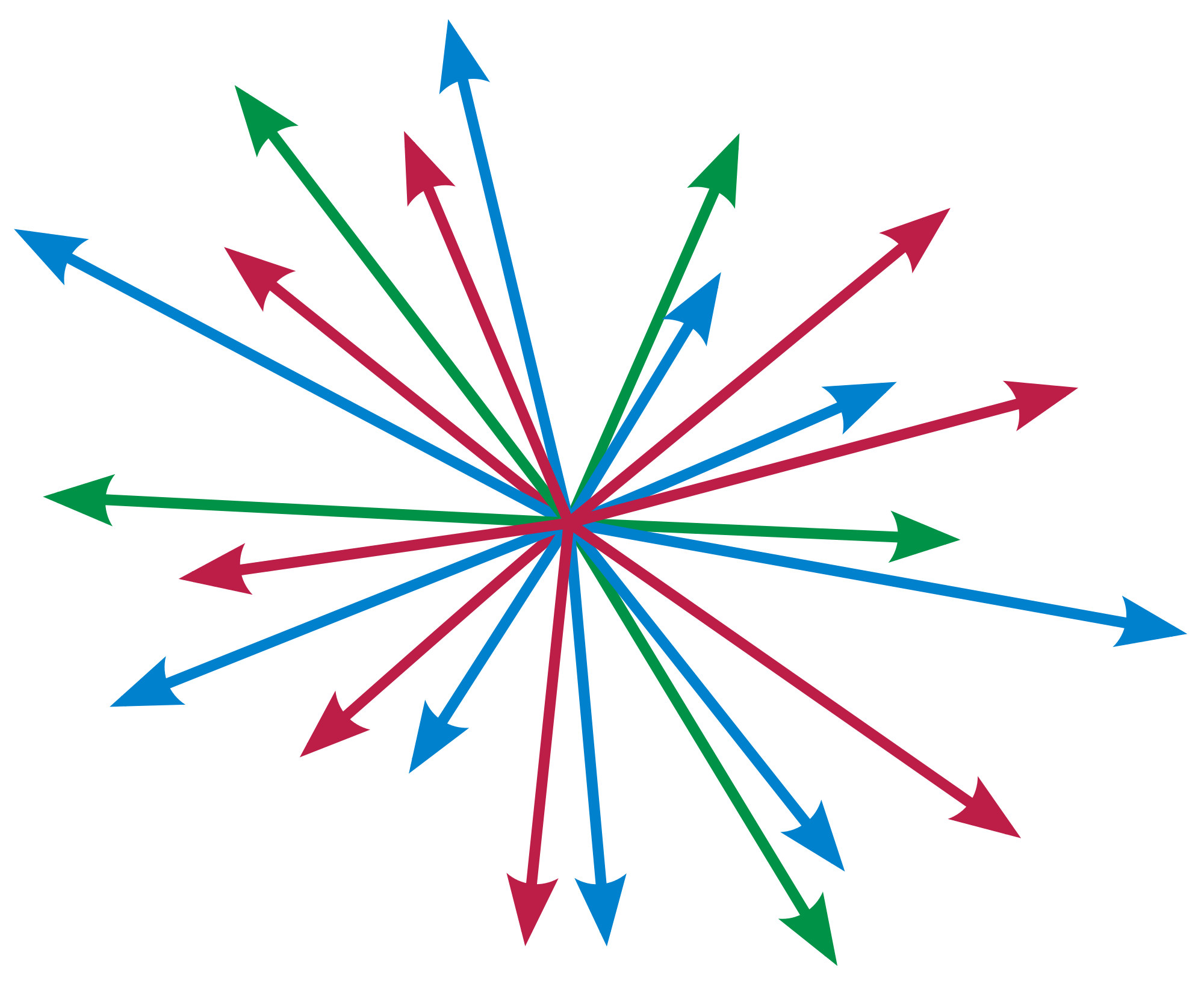Linear Algebra (Part II. Spaces)

Having intoduceed some basic operations and concepts of matrices and linear equations, we can now move into the core part of linear algebra.
Vector Space
Notations and Basic Concepts
Notation \(\mathbf{F}\)
\(\mathbf{F}\) stands for either \(\mathbf{R}\) or \(\mathbf{C}\). A theorem involving \(\mathbf{F}\) means that it holds when \(\mathbf{F}\) is replaced by \(\mathbf{R}\) or \(\mathbf{C}\).
The letter \(\mathbf{F}\) is used because \(\mathbf{R}\) and \(\mathbf{C}\) are examples of fields.
Then we are going to define \(\mathbf{R}^n\) and \(\mathbf{C}^n\). Look at the following example:
To generalize \(\mathbf{R}^2\) and \(\mathbf{R}^3\) to higher dimensions, we first need to discuss lists .
List and length
A list of length \(n\) is an ordered colletcion of \(n\) elements, denoted as: \[ (x_1,...,x_n) \] Two lists are said equal if and only if their ordered elements and length are exactly the same.
Definiton \(\mathbf{F}^n\)
\(\mathbf{F}^n\) is the set of all lists of length \(n\) of elents of \(\mathbf{F}\): \[ \mathbf{F}^n=\{(x_1,...,x_n):x_j\in\mathbf{F}\space for\space j=1,...,n\} \]
Definition of Vector Space
A vector space is a set \(V\) along with an addition on \(V\) and a scalar multiplication on \(V\) such that the following properties hold:
Commutativity: \(u+v=v+u\) for all \(u,v\in V\);
Associativity: \((u+v)+w=u+(v+w)\) and \((ab)v=a(bv)\) for all \(u,v,w \in V\) and all \(a,b \in \mathbf{F}\);
Additive identity: there exists an element \(0 \in V\) such that \(v+0=v\) for all \(v \in V\);
Additive inverse: for every \(v \in V\), there exists \(w \in V\) such that \(v+w=0\);
Multiplicative identity: \(1v=v\) for all \(v \in V\);
Distributive Properties: \(a(u+v)=au+av\) and \((a+b)v=av+bv\) for all \(a,b \in \mathbf{F}\) and all \(u,v\in V\).
We can use some geometric language to help our intuition. We call elements of a vector space vectors or points. In other words, an \(xy\) plane is a vector space \(V\) and all the points in this plane are the elements of \(V\). A real vector space is a set of "vectors" together with rules for vector addition and for multiplication by real numbers.
Note that the vetors here can be anything you like, from matrices to real functions.
Also, we can apply this definition into \(\mathbf{F}\), and we will find that \(\mathbf{F}\) has a good property.
Operations in \(\mathbf{F}^n\)
Addition \[ (x_1,...,x_n)+(y_1,...,y_n)=(x_1+y_1,...,x_n+y_n). \]
Zero Vector
\[ 0=(0,...0). \]
- Additive Inverse
For \(x\in\mathbf{F}^n\), additive inverse is the vector \(-x\in\mathbf{F}^n\) such that \[ x+(-x)=0. \]
- Scalar Multiplication
\[ \lambda (x_1,...,x_n)=(\lambda x_1,...,\lambda x_n).(\lambda \in \mathbf{F}) \]
Notation \(\mathbf{F}^S\)
If \(S\) is a set, then \(\mathbf{F}^S\) denotes the set of functions from \(S\) to \(\mathbf{F}\). And \(\mathbf{F}^S\) also holds following features:
- For \(f,g\in \mathbf{F}^S\), the sum \(f+g\in \mathbf{F}^S\) is the function defined by
\[ (f+g)(x)=f(x)+g(x) \]
for all \(x\in S\).
- For \(\lambda \in \mathbf{F}\) and \(f\in \mathbf{F}^S\), the scalar multiplication \(\lambda f\in \mathbf{F}^S\) is the fucntion defined by
\[ (\lambda f)(x)=\lambda f(x) \]
for all \(x\in S\).
And it's obvious that \(\mathbf{F}^S\) is a vector space because the operations defined above are just alike those defined in \(\mathbf{F}^n\).
\(\mathbf{R}\cup\{\infty\}\cup\{-\infty\}\) is not a vector space as \((a+b)v=av+bv\) for all \(a,b \in \mathbf{F}\) and all \(u,v\in V\) does not hold with this counter example: \[ (-1+2)\infty=1\cdot\infty=\infty, \] However, \[ -1\cdot\infty+2\cdot\infty=-\infty+\infty=0. \]
Subspaces
Definition and Conditons of subspaces
Definition: A subset \(U\) of \(V\) is called a subspace of \(V\) if \(U\) is also a vector space.
Conditions: A subset \(U\) is a vector space of \(V\) if and only if the following conditions hold:
- \(0\in U\).
- \(u+w\in U\) for \(u,w\in U\).
- \(au\in U\) for \(a\in F\) and \(u \in U\).
Proof:
"\(\Rightarrow\)": If the given \(U\) is a subspace, then \(0\in U\), so \(0=0+b\Rightarrow b=0\).
"\(\Leftarrow\)": If \(b=0\), then \(U=\{(x_1,x_2,5x_4,x_4),x_1...x_4\in\mathbf{F}^4\}\).
- iIt's obviously that \(0\in U\).
- let \(u=(x_1,x_2,5x_4,x_4)\) and \(v=(y_1,y_2,5y_4,y_4)\), then \(u+v=(x_1+y_1,x_2+y_2,5(x_4+y_4),x_4+y_4)\in U\).
- Obviously, \(cu\in U\).
Proof:
\(f=0\), obviously satisfied.
\(f+g=h\) is also continuous
\(cf\) is also continuous.
Proof:
"\(\Leftarrow\)": Suppose \(V_1\subseteq V_2\), then \(V_1\cup V_2=V_2\), which is definitely a subspace.
"\(\Rightarrow\)": Target: \(\forall x\in V_1,x\in V_2.\)
Suppose that \(V_1\) and \(V_2\) are two subspaces, and \(x\in V_1,y\in V_2-V_1\).
Let \(U = V_1 \cup V_2\). \(x\in U,y\in U\). and \(U\) is a subspace, therefore:
\(x+y\in U\), therefore \(x+y\in V_1\) or \(x+y\in V_2\).
- \(\forall x\in V_1,\space y\in V_2-V_1\), \(x+y\in V_1\): then \((x+y)+(-x)=y\in V_1\). A contradicition!
- \(\forall x\in V_1,\space y\in V_2-V_1\), \(x+y\in V_2\): then \((x+y)+(-y)=x\in V_2\), then we are done as \(\forall x\in V_1,x\in V_2.\) So \(V_1\subseteq V_2\).
Finite-Dimensional Vector Spaces
Span and Linear Independence
Linear Combination:
A linear combination of a list \(v_1,...,v_m\) of vectors in \(V\) is a vector of the form \[ a_1v_1+\cdots+a_mv_m \] where \(a_1,...,a_m\in\mathbf{F}.\)
Span:
The set of all linear combinations of a lisy of vectors \(v_1,...,v_m\) in \(V\) is called the span of \(v_1,...,v_m\), denoted as span\((v_1,...,v_m)\). In other words, \[ \mathbf{span} (v_1,...v_m)=\{a_1v_1+\cdots a_mv_m:a_1,...,a_m\in\mathbf{F}\}. \] If \(\mathbf{span}(v_1,...v_m)=V\), we say that \(v_1,...v_m\) spans \(V\).